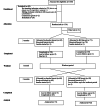The Effect of Salacia Reticulata Extract Biscuits on Blood Sugar Control of Type 2 Diabetes Mellitus Patients: A Two-Period, Two-Sequence, Crossover, Randomized, Triple-Blind, Placebo-Controlled, Clinical Trial
- PMID: 37885536
- PMCID: PMC10599346
- DOI: 10.7759/cureus.45921
The Effect of Salacia Reticulata Extract Biscuits on Blood Sugar Control of Type 2 Diabetes Mellitus Patients: A Two-Period, Two-Sequence, Crossover, Randomized, Triple-Blind, Placebo-Controlled, Clinical Trial
Abstract
Background Traditional physicians in Sri Lanka and India use extracts from the plant Salacia reticulata,or Kothala Himbutu (KH) to treat diabetes. The effect of a KH biscuit, taken as a snack, on glycemic control was investigated in patients with type 2 diabetes. Methodology This triple-blind, randomized, placebo-controlled, two-period, two-sequence, crossover study was conducted in the Internal Medical Clinic, Teaching Hospital Anuradhapura. A research assistant opened computer-generated random numbers enclosed in a sealed envelope and performed treatment allocation. The group outcome was masked from the researchers, patients, and analysts. Both the placebo and the KH biscuit were identical. The primary outcome measure was HbA1c. Intention to treat analyses was used. Glycemic stability was assured in the run-in period, and patients with severe renal, liver, or heart disease were excluded. If patients needed insulin, they were withdrawn from the trial. Results From January 2014 to May 2016, 230 patients were screened, and 136 were randomized. Of them, 62 were allocated, 58 completed the placebo biscuit, 71 were allocated, and 69 completed the KH biscuit. After the washout period and crossover, 57 completed the KH and 65 completed the placebo biscuit. The baseline mean HbA1c level was 8.45% (68.9 mmol/mol) and 8.65% (71.0 mmol/mol) for the placebo-KH biscuit and KH-placebo biscuit groups. At the end of the trial, the HbA1c levels in the placebo-KH biscuit group and the KH-placebo biscuit group were 8.23% (66.4 mmol/mol) and 8.53% (69.3 mmol/mol), respectively. The unadjusted mean HbA1c reduced from the baseline with 0.10% (95% CI = -0.12, 0.32) after the placebo biscuit and 0.35% (95% CI = 0.10, 0.60) after the KH biscuit. After the placebo and KH biscuits, the HbA1c values were 8.46% (95% CI = 8.19, 8.73) (69 mmol/mol with 95% CI = 66, 72) and 8.19% (95% CI = 7.90, 8.48) (66 mmol/mol with 95% CI = 63, 69), respectively. The paired sample t-test shows that the reduction was not significant for placebo biscuits (p = 0.324), while it is significant for KH biscuits (p = 0.003). Analysis with multiple imputations confirmed a significant difference between the placebo and KH biscuit in reducing the HbA1c level. Conclusions KH biscuit taken as a snack reduces HbA1c by 0.25% compared to placebo without serious renal or liver adverse effects. The biscuit can be safely recommended as a snack to patients with type 2 diabetes.
Keywords: biscuit; glycosylated hemoglobin; randomized clinical trial; salacia reticulata; snack; type 2 diabetes.
Copyright © 2023, Siribaddana et al.
Conflict of interest statement
The authors have declared that no competing interests exist.
Figures


Similar articles
-
A double blind randomised placebo controlled cross over study of a herbal preparation containing Salacia reticulata in the treatment of type 2 diabetes.J Ethnopharmacol. 2005 Feb 28;97(2):215-8. doi: 10.1016/j.jep.2004.10.026. Epub 2005 Jan 7. J Ethnopharmacol. 2005. PMID: 15707755 Clinical Trial.
-
Efficacy and safety of a novel dual GIP and GLP-1 receptor agonist tirzepatide in patients with type 2 diabetes (SURPASS-1): a double-blind, randomised, phase 3 trial.Lancet. 2021 Jul 10;398(10295):143-155. doi: 10.1016/S0140-6736(21)01324-6. Epub 2021 Jun 27. Lancet. 2021. PMID: 34186022 Clinical Trial.
-
Efficacy and safety of janagliflozin monotherapy in Chinese patients with type 2 diabetes mellitus inadequately controlled on diet and exercise: A multicentre, randomized, double-blind, placebo-controlled, Phase 3 trial.Diabetes Obes Metab. 2023 May;25(5):1229-1240. doi: 10.1111/dom.14971. Epub 2023 Jan 20. Diabetes Obes Metab. 2023. PMID: 36594724 Clinical Trial.
-
Liraglutide in people treated for type 2 diabetes with multiple daily insulin injections: randomised clinical trial (MDI Liraglutide trial).BMJ. 2015 Oct 28;351:h5364. doi: 10.1136/bmj.h5364. BMJ. 2015. PMID: 26512041 Free PMC article. Clinical Trial.
-
Salacia reticulata (Kothala himbutu) revisited; a missed opportunity to treat diabetes and obesity?Nutr J. 2015 Feb 27;14:21. doi: 10.1186/s12937-015-0013-4. Nutr J. 2015. PMID: 25889885 Free PMC article. Review.
References
-
- Trends in alternative medicine use in the United States, 1990-1997: results of a follow-up national survey. Eisenberg DM, Davis RB, Ettner SL, Appel S, Wilkey S, Van Rompay M, Kessler RC. JAMA. 1998;280:1569–1575. - PubMed
-
- Hypoglycaemic activity of some medicinal plants in Sri-Lanka. Fernando MR, Thabrew MI, Karunanayake EH. https://linkinghub.elsevier.com/retrieve/pii/030636239091033N. Gen Pharmacol. 1990;21:779–782. - PubMed
-
- Preventive effects of Salacia reticulata on non-alcoholic fatty liver disease (NAFLD)/ non-alcoholic steatohepatitis (NASH) in monosodium glutamate treated mice. Watanabe M, Shimada T, Iiduka S, et al. J Trad Med. 2011;28:73–82.
LinkOut - more resources
Full Text Sources
